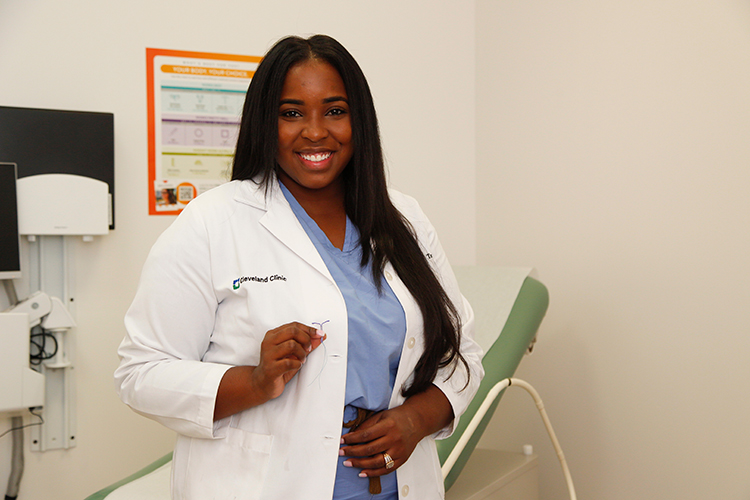According to the Centers for Disease Control and Prevention (CDC), nearly half of the pregnancies in the United State are unintended, and of those about 95 percent occur in women who do not use contraception or women who use it inconsistently or incorrectly.
Increasing access to contraception helps women avoid pregnancies they do want and plan the pregnancies they do, and the CDC now recommends that healthcare providers encourage their patients to consider long-acting and reversible contraceptives (LARC) to reduce the risk of unintended pregnancies and rapid repeat pregnancies.
“There are so many things we can offer our patients other than birth control pills to prevent unwanted pregnancies,” said Dr. Crystal Taylor, who practices obstetrics and gynecology at Cleveland Clinic’s Partners in Women’s Health.
“LARCs are the newest and most effective contraceptives. They offer long-acting and completely reversible protection. They are good for preventing pregnancy when they are in place and then you can remove it and have your fertility back immediately when you are ready to get pregnant.”
The latest intrauterine device (IUD) and the birth control implant are LARC methods that are safe and highly effective birth control for women of all ages. Teenagers, women who have given birth and women who have never given birth can use these methods.
They are also good methods for women to use immediately after giving birth. During the first year of use, fewer than 1 in 100 women using an IUD or implant will get pregnant and, over time, LARC methods are 20 times more effective than birth control pills, the patch or the ring.
An IUD is a small, T-shaped plastic device that is inserted into and left inside the uterus. Some IUDs are hormonal, and some are non-hormonal. The hormonal IUD releases the hormone progestin into the uterus and can be effective for up to seven years. The copper IUD does not contain hormones and is approved for up to 10 years of use.
“We decide on which one would be best for the patient based on various things. Some patients don’t like hormones and want to go a more natural route, so we’ll use the copper Paragard IUD,” Dr. Taylor explained. “If they desire hormones and their cycles are a little heavier than normal, hormones will help decrease the bleeding and so we go with a progesterone containing Mirena IUD.” (Progesterone and estrogen are hormones found in birth control pills.)
The IUD works by preventing fertilization of an egg by sperm. The progestin in the hormonal IUD thickens mucus found in the cervix, making it harder for the sperm to enter the uterus and reach an egg. Progestin also thins the lining of the uterus. The copper in the copper IUD interferes with sperm’s ability to move, and when the sperm stops acting normally it’s harder for them to enter the uterus and reach an egg.
“The beauty of the IUD is that you don’t have to think about taking medication daily as you would with a birth control pill,” Dr. Taylor said. “Once the IUD is in place you don’t have to do anything. Then when you want to get pregnant, you just take it out. Using an IUD does not affect your ability to get pregnant in the future and you can start trying to get pregnant immediately after you remove it.”
Side effects from the IUD can include changes in menstrual bleeding. Some changes are temporary and may go away as your body adjusts to the IUD, while others may last as long as you have the device.
Hormonal IUDs may cause frequent spotting and heavier bleeding in the first months but that decreases over time. For some women using a hormonal IUD, menstrual bleeding stops completely. Any changes that concern you should be discussed with your healthcare professional.
The second type of LARC is a hormonal implant that goes inside the upper arm. The flexible, plastic rod about the size of a matchstick is inserted just under the skin and releases progestin into the body. It prevents pregnancy by stopping ovulation. The progestin in the implant also thickens the mucus of the cervix, which makes it harder for sperm to enter the uterus and reach the egg. The implant procedure only takes a few minutes, and the protection lasts for years.
“While the implant can’t be seen, it can be felt,” Dr. Taylor said. “We want you to feel it because it can migrate inside the arm. It too can cause irregular bleeding patterns, but it is nothing to worry about. Just like the IUD, it can be easily removed once you want to become pregnant and your fertility will be restored immediately. The implant has actually been proven to be more effective than tubal ligation, which requires surgery.”
Because of the simplicity and effectiveness of LARCs, there has been a steady decrease in unwanted pregnancies. If all U.S. women had access to LARC, the country could see a 64 percent drop in unintended pregnancies, 63 percent drop in unintended births and 67 percent drop in abortions, according to a 2017 analysis from the nonprofit research organization Child Trends.
Most insurances cover LARCs, and you can discuss LARC birth control options with your gynecologist to determine which one is best for you.
Dr. Crystal Taylor received her medical degree from Florida State University College of Medicine and completed her residency in OB-GYN at the University of Texas Health Science Center at Houston. The native Floridian moved to Vero Beach to be closer to her parents in Miami and joined Cleveland Clinic just few months ago. She is accepting new patients at Partners in Women’s Health, 1050 37th Place, Vero Beach. Call 772-770-6116 to schedule an appointment.

